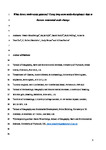What drives biodiversity patterns? Using long-term multi-disciplinary data to discern centennial-scale change
| dc.contributor.author | Woodbridge, Jessie | |
| dc.contributor.author | Fyfe, R | |
| dc.contributor.author | Smith, D | |
| dc.contributor.author | Pelling, R | |
| dc.contributor.author | de Vareilles, A | |
| dc.contributor.author | Batchelor, R | |
| dc.contributor.author | Bevan, A | |
| dc.contributor.author | Davies, A | |
| dc.date.accessioned | 2020-11-05T12:27:10Z | |
| dc.date.issued | 2021-03 | |
| dc.identifier.issn | 0022-0477 | |
| dc.identifier.issn | 1365-2745 | |
| dc.identifier.uri | http://hdl.handle.net/10026.1/16636 | |
| dc.description.abstract |
<jats:title>Abstract</jats:title><jats:p> <jats:list> <jats:list-item><jats:p>Biodiversity plays an important role in ecosystem functioning, habitat recovery following disturbance and resilience to global environmental change. Long‐term ecological records can be used to explore biodiversity patterns and trends over centennial to multi‐millennial time‐scales across broad regions. Fossil pollen grains preserved in sediment over millennia reflect palynological richness and diversity, which relates to changes in landscape diversity. Other long‐term environmental data, such as fossil insects, palaeoclimate and archaeologically inferred palaeodemographic (population) data, hold potential to address questions about the drivers and consequences of diversity change when combined with fossil pollen records.</jats:p></jats:list-item> <jats:list-item><jats:p>This study tests a model of Holocene palynological diversity change through a synthesis of pollen and insect records from across the British Isles along with palaeodemographic trends and palaeoclimate records. We demonstrate relationships between human population change, insect faunal group turnover, palynological diversity and climate trends through the Holocene.</jats:p></jats:list-item> <jats:list-item><jats:p>Notable increases in population at the start of the British Neolithic (~6,000 calendar years before present [<jats:sc>bp</jats:sc>]) and Bronze Age (~4,200 <jats:sc>bp</jats:sc>) coincided with the loss of forests, increased agricultural activity and changes in insect faunal groups to species associated with human land use. Pollen diversity and evenness increased, most notably since the Bronze Age, as landscapes became more open and heterogeneous. However, regionally distinctive patterns are also evident within the context of these broad‐scale trends. Palynological diversity is correlated with population while diversity and population are correlated with some climate datasets during certain time periods (e.g. Greenland temperature in the mid‐late Holocene).</jats:p></jats:list-item> <jats:list-item><jats:p><jats:italic>Synthesis</jats:italic>. This study has demonstrated that early human societies contributed to shaping palynological diversity patterns over millennia within the context of broader climatic influences upon vegetation. The connections between population and palynological diversity become increasingly significant in the later Holocene, implying intensifying impacts of human activity, which may override climatic effects. Patterns of palynological diversity trends are regionally variable and do not always follow expected trajectories. To fully understand the long‐term drivers of biodiversity change on regionally relevant ecological and management scales, future research needs to focus on amalgamating diverse data types, along with multi‐community efforts to harmonise data across broad regions.</jats:p></jats:list-item> </jats:list> </jats:p> | |
| dc.format.extent | 1396-1410 | |
| dc.format.medium | Undetermined | |
| dc.language | en | |
| dc.language.iso | en | |
| dc.publisher | Wiley | |
| dc.subject | biodiversity | |
| dc.subject | biogeography and macroecology | |
| dc.subject | global change ecology | |
| dc.subject | insects | |
| dc.subject | land-cover change | |
| dc.subject | landscape ecology | |
| dc.subject | land-use change | |
| dc.subject | palaeoecology and land-use history | |
| dc.title | What drives biodiversity patterns? Using long-term multi-disciplinary data to discern centennial-scale change | |
| dc.type | journal-article | |
| dc.type | Journal Article | |
| plymouth.author-url | https://www.webofscience.com/api/gateway?GWVersion=2&SrcApp=PARTNER_APP&SrcAuth=LinksAMR&KeyUT=WOS:000600035300001&DestLinkType=FullRecord&DestApp=ALL_WOS&UsrCustomerID=11bb513d99f797142bcfeffcc58ea008 | |
| plymouth.issue | 3 | |
| plymouth.volume | 109 | |
| plymouth.publication-status | Published | |
| plymouth.journal | Journal of Ecology | |
| dc.identifier.doi | 10.1111/1365-2745.13565 | |
| plymouth.organisational-group | /Plymouth | |
| plymouth.organisational-group | /Plymouth/Admin Group - REF | |
| plymouth.organisational-group | /Plymouth/Admin Group - REF/REF Admin Group - FoSE | |
| plymouth.organisational-group | /Plymouth/Faculty of Science and Engineering | |
| plymouth.organisational-group | /Plymouth/Faculty of Science and Engineering/School of Geography, Earth and Environmental Sciences | |
| plymouth.organisational-group | /Plymouth/REF 2021 Researchers by UoA | |
| plymouth.organisational-group | /Plymouth/REF 2021 Researchers by UoA/UoA14 Geography and Environmental Studies | |
| plymouth.organisational-group | /Plymouth/Research Groups | |
| plymouth.organisational-group | /Plymouth/Research Groups/Centre for Research in Environment and Society (CeRES) | |
| plymouth.organisational-group | /Plymouth/Research Groups/Centre for Research in Environment and Society (CeRES)/CeRES (Reporting) | |
| plymouth.organisational-group | /Plymouth/Research Groups/Marine Institute | |
| plymouth.organisational-group | /Plymouth/Users by role | |
| plymouth.organisational-group | /Plymouth/Users by role/Academics | |
| dcterms.dateAccepted | 2020-10-30 | |
| dc.rights.embargodate | 2021-11-29 | |
| dc.identifier.eissn | 1365-2745 | |
| dc.rights.embargoperiod | Not known | |
| rioxxterms.versionofrecord | 10.1111/1365-2745.13565 | |
| rioxxterms.licenseref.uri | http://www.rioxx.net/licenses/all-rights-reserved | |
| rioxxterms.licenseref.startdate | 2021-03 | |
| rioxxterms.type | Journal Article/Review |


